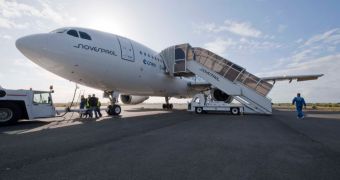Today, June 6, officials at the European Space Agency (ESA) will conduct their first-ever flight with a new aircraft, designed to emulate the gravitational conditions of Mars and the Moon as accurately as possible. The ‘Zero-G’ Airbus will fly for the first time today.
For the agency, the aircraft is a new way to fly sensitive experiments into space without actually taking them to the International Space Station (ISS). The new work could bring valuable contributions to technologies needed to explore the Red Planet, and beyond.
While the Airbus airplane will not be capable of emulating the performances of NASA's famous Vomit Comet aircraft – which can emulate actual zero gravity – it will be able to produce only a fraction of Earth's gravity, which is what astronauts on the Moon or Mars would experience.
Today's flights are part of the Joint European Partial-g Parabolic Flight campaign, which was organized by the French space agency CNES, the German Aerospace Center (DLR) and ESA. This is an unprecedented research mission for all actors involved.
In order to create Moon and Mars gravity-like conditions, the Airbus pilots will follow special parabolic paths that have been drawn out for them. Only during the final parabola will the aircraft at last provide full weightlessness conditions for its passengers.
“Each flight can provide a total of up to 12 minutes of partial gravity inside the aircraft. The Airbus A300, owned by Novespace, will perform consecutive flights on the three days starting tomorrow from Mérignac-Bordeaux airport, France,” an ESA press release said yesterday.
“Lunar and Martian reduced-gravity environments will provide scientists with additional data at different gravity levels,” campaign managers explain today. “This is a unique campaign in the world, and we have received outstanding scientific proposals from all over Europe,” they add.
The three agencies selected a total of 13 European research projects for testing during the three-day research effort. The prospect of having access to this new partial gravity opportunity made numerous research groups prepare their experiments extremely well.
“The experiments cover a wide range of research, such as biology, human physiology and physics, as well as technology demonstrations,” ESA officials went on to say.
“The goal is improve our knowledge about how systems react to different accelerations and where the level of sensitivity is,” they concluded.

 14 DAY TRIAL //
14 DAY TRIAL //